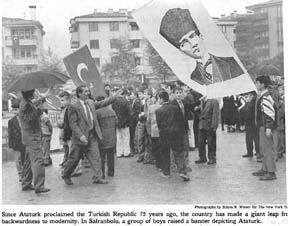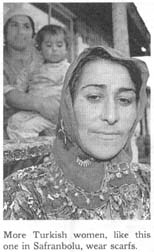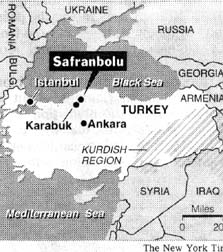|
|
An anti-Ataturk
jeweler in this New York Times article is quoted as
saying, "They don’t want our women to wear headscarfs. But why shouldn’t
they? Isn’t that democracy?” He's right... unfortunately, things aren't as
simple as all that. Once the dogma of fundamentalism takes hold, it would be a
giant step backward for any nation. The greatest allies of Armenians and
Greeks are the cobweb-minded Islamists of Turkey, who only came into being in
the 1980s with the stupid decision to accentuate religious schools. Just as
these medieval minds played a strong role in leading to the demise of The
Ottoman Empire, they are poised to do so again in the more modern version of
their nation... if given half a chance.
The Second article is
entitled "The Menace Of Religious Zealotry," exploring the question
of fundamentalism increasingly directing global politics.
|
|
|
| The Alarming Scarf
and Other Turkish Worries |
Safranbolu Journal
The Alarming Scarf and Other Turkish Worries
The New York Times
October 29, 1998
By STEPHEN KINZER
SAFRANBOLU, Turkey, Oct. 25 —
Festive banners fluttered from lampposts and windows as a troupe of young folk dancers
prepared to mount a makeshift stage here on Saturday morning. Like tens of millions of
Turks across the country this week, they were joining in celebrations of their country’s
75th birthday.
 |
|
Since Ataturk proclaimed the
Turkish Republic
75 years ago, the country has made a giant leap
from backwardness to modernity. In Safranbolu, a
group of boys raised a banner depicting Ataturk.
|
One dancer, Gulcan Eran, 16, seemed a symbol of Turkey
itself. She is thoroughly modern and Western-oriented, vibrant, self-confident and
ambitious for a career as an engineer. But as Ms. Eran adjusted her resplendent costume,
two young women wearing traditional headscarfs walked across the plaza nearby. She turned
serious.
“I wouldn’t object if the scarf was just about religion, but it isn’t anymore,”
she said. “It’s a political uniform. It’s a way of saying that you want to get rid
of the secular republic. I think it’s very dangerous.”
Turks who are gathering this week for festivities ranging from poetry recitals to
kick-boxing matches have reason for self-congratulation. Their country has made a giant
leap from backwardness to modernity in 75 years, and the nearly two dozen foreign leaders
due at the central commemoration in Ankara on Thursday reflect its role as a regional
power.
But as Turkey seeks to establish a stable democracy for its 65 million people, it also
confronts several persistent problems. Defining the role of religion in public life is
only the most visible.
Both Turkey’s achievements and its looming challenges are clearly visible here in
Safranbolu, a pleasant town of 20,000 nestled in the rocky Anatolian plateau. It is known
for its 19th-century Ottoman buildings, and attracts a modest stream of tourists. Some
residents till small farms on outlying hills. Others work at a steel mill in nearby
Karabuk that offers employment to thousands but also casts a rancid cloud over the town.
The streets here are tree-shaded, houses are
sturdy and well kept, schools are full and clinics modern. Shops offer all manner of
domestic and imported goods.
“We’ve made a lot of progress in 75 years,” said Ozcan Cakir, 45, manager of a small
candy factory in Safranbolu. “This will never be a backward or Middle East-type country
again. But I worry about the future. There’s hunger in Turkey. I can afford to send my
kids to college, but people who work for me can’t. That produces resentment, and in 10
or 15 years that resentment could bring trouble.”
Several portraits of Mustafa Kemal Ataturk, who proclaimed the Turkish Republic on Oct.
29, 1923, decorate Mr. Cakir’s salesroom. They mark him as a dedicated supporter of the
secular order. But at the jewelry store next door, there is no Ataturk portrait.
“Twenty-five percent of our peoplc don’t support this kind of secularism,” said the
jeweler, Ahmet Pulcu, suggesting that he is among them. “The rest have no idea what
religion is. They don’t want our women to wear headscarfs. But why shouldn’t they? Isn’t
that democracy?”
 |
|
Scarf-wearing
woman
|
|
In Safranbolu, as in many Turkish cities and
towns, measurably more women wear headscarfs than wore them only a couple of years
ago. It is a sign of growing religiosity that the Islamic movement encourages. But
it disturbs some secularists, among them military officers. Turkish universities
have banned the wearing of headscarfs by female students, giving Islamic politicians
a vivid issue. They are crisscrossing the country telling voters that their
daughters are being excluded from tax-supported universities simply because they are
devout Muslims.
The air force commander, Gen. Ilhan Kilic, vowed recently that the military would
fight every effort aimed at “undermining this system and turning the country into
an anachronism.” Many Turks say that this uncompromising attitude guarantees the
survival of the secular republic. But others fear that it is polarizing the nation
and perhaps setting the stage for confrontation.
Turkey also confronts the question of how to deal with its large Kurdish minority.
That issue is also palpable in Safranbolu.
On a hillside just a few minutes’ walk from the town center is Safranbolu’s
Kurdish quarter. To enter it is to pass from the developed world into poverty.
The town’s 700 Kurds live in ramshackle cabins without running water. Many are
dirty, poorly dressed and have open sores on their faces or arms. Almost all are
unemployed.
“We’re Turks, but second-class,” said Bilal Cetinceviz, 65, a community
leader. “People don’t like us or don’t trust us. When we apply for jobs, we
don’t get hired. Our kids don’t go to school because we can’t afford to buy
them books and clothes.”
“When you have no work, you have nothing to lose,” Mr. Cetinceviz said. “Every
once in a while some radical Kurd shows up here and tries to turn us into militants.
We throw them out, but if we didn’t, in six months everyone here would be a
militant.”
Many Kurds in Turkey have risen to leading positions, but many others have been left
behind by the country’s economic boom. While coastal regions thrive, the mainly
Kurdish southeast is impoverished.
Kurdish guerrillas have been fighting a separatist war there for 14 years. Thirty
thousand people have been killed in the conflict. It costs an estimated $8 billion a
year to wage, and ties down more than 200,000 Turkish soldiers.
|
|

|
|
Turkey’s achievements and
challenges are visible in Safranbolu.
|
|
The questions of poverty. religious fundamentalism and Kurdish
identity hang over Safranbolu as they do over the rest of Turkey. Over the last two years,
however, a new topic has emerged at cafes and teahouses.
Spectacular disclosures about ties between gangsters and the Government have shaken public
faith in the political system. Phrases like “black money” and “state gangs” are
now part of everyday conversation.
The spreading scandal has produced grave allegations against several of the country’s
past and present leaders, but investigations have been limited. Magistrates do not have
unfettered freedom to pursue cases against political figures. Cynicism is growing, even
among many who until recently refused to believe that agencies of their Government could
ever have sponsored death squads or tolerated smuggling or other crime and gangs,” said
Aybar Toker, the local soft drink bottler. “People think all the established parties are
involved, so they vote for the Islam party as a protest.”
If Turkey’s greatest challenge in the years ahead is to forge a nations consensus over
how to establish full democracy here, it must have political leaders who can lead the way.
Yet many Turks believe that the political system is closed to them. Parties are run by
bosses who tolerate little dissent, and as a result many talented men and women shun
politics in favor of business, academia or journalism.
“It’s true that our political system is very closed, but business people are beginning
to take a much greater role in society, and they aren’t bound by all these taboos,”
said Yuksel Oktay, 61, an American-educated engineer who grew up in Safranbolu and visits
periodically. “I also see a great potential in our youth. They understand what is at
stake here, and they won’t let Turkey slip backward.”
“We have problems, but I think most Turks would be optimistic about our chances of
solving them,” Mr. Oktay said. “I certainly am.”
|
The Menace Of
Religious Zealotry
|
The Menace Of Religious Zealotry
Fundamentalism Increasingly Directs Global Politics.
Is Compromise Going To Be A Thing Of The Past?
By Kevin Phillips
copyright 1998 Los Angeles Times
Fifty years have passed since Winston Churchill made his speech observing that, from
Stettin on the Baltic to Fiume on the Adriatic, an Iron Curtain was dividing Europe.
Not any more. But now a new potential divide is becoming visible in Europe and Asia.
Religious zealotry is one hallmark of the escalating confrontation between the West
and a number of Muslim nations along a line from North Africa to Malaysia and
Indonesia. Radicalism in many religions is as obvious in parts of Brooklyn, Chicago
and South Carolina as in Turkey and Algeria, but Islamic fundamentalism is growing
the fastest and has the best prospect of intrafaith gains.
Like crusading Catholicism in the Middle Ages and the aggressive Protestantism of
the Reformation, militant
Islam is not simply aroused by its own cause, but also is responding to the
hostility of the existing Muslim power structure — from old-guard Persian Gulf
emirs to progressive secular Turks — and the all-too-frequent cultural and
economic arrogance of the West. Throw in evidence of China and the overseas Chinese
being frequent Muslim allies, and the looming 2lst century geography is as powerful
as the cultural fit and the population numbers.
The Chinese and Muslims together now have double the West’s share of world
military manpower, after trailing at the end of World War ll.Though the West
currently has twice their combined economic strength, its key remaining bulwark,
some Chinese-growth projections suggest that could fade by 2020.
Harvard Professor Samuel P. Huntington has predicted that culture and religion will
shape the new century’s clash of civilizations. If so, forget the Maginot Line of
World War II. To paraphrase the great battle hymn of Reformation Luthranism:
The new mighty fortresses may be our gods. By 2009, we may have to worry about
whether World War III could start along the Minaret Line.
Just consider the Middle East. As recently as 30 or 40 years ago, rivalries there
were a mix of Arab-Israeli enmity, the legacies of colonialism — for example, the
British and French invasion of Suez in l956—and U.S.-Soviet Cold War jousting.
Since then, religious commitment and activism have surged. Fundamentalism is gaining
in most Muslim nations, save for Iran, mullah driven for so long that there seems a
slight thaw now.
Israel, in turn, has a government dominated by the Jewish equivalent of America’s
religious right:
Greenville, S.C., in yarmulkes.
Russian activism in the Mideast also seems increasingly influenced by the old
Orthodox nationalism of the czars. One academic expert, Edward L. Keenan, has
compared the rise of the religious right in Russia to that of Israel: In both, it
consists mostly of the poor and young reacting against Westernized elites.
In the United States, members of the Southern Baptist Church, the most
fundamentalist of the major denominations, dominate Washington politics: President
Bill Clinton, Vice President Al Gore and House
Minority Leader Richard A. Gephardt (D-Mo.) for the Democrats; House Speaker Newt
Gingrich of
Georgia, Senate Majority Leader Trent Lott of Mississippi and Sen. Strom Thurmond of
South Carolina
for the GOP.
None of these men takes the Bible literally, even if many fellow Baptists do.
Several have even whittled the 10 Commandments down to five or six. Nonetheless,
they’re well aware of the importance of the biblical lands in the Middle East to
U.S. voters: George Bush won 90% job approval with a successful war against a
regional tyrant. Through such calculations, religion is a powerful force in U.S.
Mideast policy.
What’s unnerving is the possibility that the biblical lands are part of a larger
zone of potential West-versus-Islam conflict that stretches almost 10,000 miles,
from the Atlantic beaches of Casablanca to the South China Sea.
A cook’s tour could begin in Morocco, Algeria, Tunisia and Moammar Kadafi’s
radical Libya. But the front-line hot spots, where Islam and the West are already
developing mutual bitterness, are big urban centers like Paris, Brussels, Frankfurt
and Berlin. Of the 12 million to 14 million Muslim immigrants in Europe—Moroccans,
Tunisians, Algerians and Turks—most crowd into these cities, nurturing radicalism
on both sides.
Further east, the 6 million to 8 million Muslims of the Balkans, a legacy from the
centuries of Ottoman rule, dominate Albania, as well as much of Bosnia and Kosovo
and part of Macedonia in the former
Yugoslavia, along with parts of Bulgaria. Fighting between Orthodox Christian Serbs
and Muslims is already widespread in Bosnia and Kosovo. A wider Balkan war with
essentially religious battle lines is quite possible. Cyprus, too, has again emerged
as a possible battleground between Greek Orthodox Chrstians and Turkish Muslims.
In and around the Holy Land, the secular Muslim states of Egypt and Turkey are also
in danger of being taken over by Islamic radicals. Either transformation could set
the region ablaze. Politics in Turkey
is particularly sensitive to how Turks and other Muslim immigrants face
discrimination in the ethnic ghettos of Western Europe, and how the European
Community is perceived as rejecting Turkish membership for ethnic and religious
reasons. The Persian Gulf is already incendiary, with the recent U.S. saber-rattling
against Iraq being taken in some quarters for hostility to all Muslims.
An additional stop on Islam’s armed frontier would be the Caucasus region, where
Muslim Chechens are fighting Orthodox Russians, and Christian Armenians are at sword’s
point with Muslim Azerbaijanis.
|
| |
Another problem area is in the largely Muslim republics of
what used to be Soviet Central Asia.
Several thousand miles across India and the Bay of Bengal, three Muslim-influenced
republics of Southeast Asia—Malaysia, indonesia and the Philippines—have their
political and economic noses out of joint from the recent financial collapses. Some
local leaders, including Malaysian Prime Minister Mahathir
Mohamad, blame the West for using the currency crisis to erode local economic
sovereignty. It is not a baseless charge. In Indonesia, with 200 million people the
most populous Muslim nation, President Suharto has been obliged to accept
International Monetary Fund reforms. The resulting fuel, electricity and
transportation increases have led to riots.
Washington policy-makers, who are caught up in “Wag the Dog” threats and
policing Southeast Asian economies through IMF bureaucrats and mutual-fund managers,
should take another look. The West is on five distinct collision courses with Islam:
the explosive Muslim immigrant ghettos could disrupt half the major cities in
Europe; U.S. troops have been put in the line of ancient hatreds in Bosnia; war
threats in the biblical lands smack of fire drills for Armageddon; the suppression
of oil prices to 25-year lows strikes at Muslim economies from Nigeria to Indonesia,
and financial colonialism is a provocation.
Should any of these problems escalate, Islam isn’t likely to stand alone. China,
Asia’s other demographic Goliath, has been a frequent ally in areas such as
nuclear nonproliferation, and the two cultures make a good fit: Chinese commercial
and financial skills with the fervent radicalism of the Muslims.
Practical proof abounds. In recent decades, countries such as Malaysia, Indonesia
and the Philippines have shown how an overseas Chinese commercial elite can build
prosperity within a largely Muslim national population. China itself has tens of
millions of Muslims; even in Hong Kong, half the small Muslim minority is ethnic
Chinese.
Together, the two groups are predicted to have 30% of the world’s population in
2010, with just 12% for the West. Compare that to 1920, when the West had 48% and
the Sino-Muslim nations 20%.
A 21st-century U.S. confrontation with this axis could be disastrous. New York and
California have large segments of the Chinese diaspora. Of the 5 million Muslims in
the United States, the Harvard Pluralism Project advised in 1997, “The Islamic
World is no longer somewhere else... instead, Chicago, with its 50 mosques and
nearly half a million Muslims, is part of the Islamic world.” Not quite. Yet, the
average American of 1998 has little idea of what global geopolitics could be like in
2010 or 2020.
---
Kevin Phillips, Publisher of American Political Report, Is Author of
“The Politics of Rich and Poor.“ His Most Recent Book is “Arrogant Capital:
Washington, Wall Street and the Frustrations of American Politics.”
|
| |
|
|